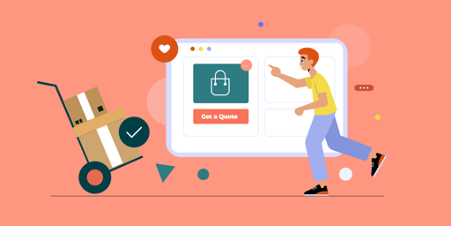Today, the bulk of commerce is conducted online. People have turned to use their portable devices, such as mobile phones or tablets, to buy goods and get services as technology has advanced. Various firms use e-commerce platforms to provide online services such as advice, services, food, apparel, lifestyle, and a variety of other products. However, reputable statistics reveal that for practically all purposes, more than 85 percent of smartphone users prefer mobile applications over e-commerce websites.
According to the findings, the app is responsible for approximately 35 percent of all mobile phone purchases. Surprisingly, just around ten percent of merchants and small business owners provide a mobile app! And when it comes to dependable and competent applications, the situation is much worse.
Customers’ Experience in the App Could Be Improved by 7 Factors
When a company chooses to develop a successful eCommerce mobile app, it must address the current trend and examine a few essential criteria that contribute to the app’s effectiveness.
Navigational simplicity and consistency
An app’s constancy eliminates the unnecessary burden of having to learn the method each time. It assists people in prioritizing what they want to see, resulting in a favorable reaction.
On the visual (buttons, typefaces, etc. ), functional (navigation, etc. ), and external (design) levels, the app must be consistent.
Some regularly used features, such as double-tap zoom, might be incorporated in a new app to create relationships with clients while also ensuring that the software performs consistently. Find out all the benefits of using ecommerce app development services here.
Simplicity in the app’s design
In a tiny location, a company owner must organize the things it sells, as well as related services and possibilities. The User Interface gives clients their initial impression of the software. An app’s straightforward and simple design fits all important features into a tiny area, allowing it to fit onto the small screen of a smartphone or tablet.
Login and checkout choices that are quick
In e-commerce, the amount of time it takes to log in and check out is critical. People’s patience has been eroded by the rising speed of the internet, and the same can be said for an app, therefore it’s critical to get it loaded fast.
Customers are more likely to return if the login procedure is simple.
A user should not input the same information over and over again, since this may cause him to go to another app; autocorrect and auto-fill features would assist an app retain users.
Shopping Cart and Checkout
The user’s cart must be displayed at all times so that the consumer may make an informed choice rather than abandoning their purchasing at the last minute. Furthermore, the checkout choices should be swift and easy to use.
The user must be able to edit and amend the order according to the wishes of the clients.
The lack of a quick and easy checkout procedure would damage the customer’s mood, increasing the likelihood of cancellation.
Accessibility
Smartphones’ intelligence makes users lethargic, and this extends to window-shopping as well. Developers of e-commerce apps must include helpful aspects that encourage users to choose certain alternatives and submit data with just one hand.
To allow the user to readily use the app, all app components must be in the thumb-friendly zone.
Added to basket, checkout, and payment choices are a few items that might be conspicuously positioned in the thumb-friendly zone.
A well-organized list of goods and services will help the app retain its user for a longer period of time.
Add to Wishlist or Favorites
Before making a final decision, consumers like to “add to favorites” or “add to their Wishlist” anything they want for them in order to get the most bang for their buck. The availability of this tab is critical to the success of an e-commerce app.
User security
Customers are asked for a variety of information by e-commerce applications, ranging from personal information to financial information such as credit card numbers.
Mobile phones and e-commerce platforms are both vulnerable to cyber-attacks. The lack of a solid firewall setup in the e-commerce app might result in a significant loss of the customer’s personal and financial assets protection. The security aspect is linked to trust, and a safe wallet with a secure payment gateway will keep a consumer loyal to the app.
Follow this link and continue reading. Find out more detailed information about the development of the company’s application for the Android platform: https://dinarys.com/android-application-development-services.






![YouTube SEO in 2024 [Definitive Guide]](https://getpixie.com/wp-content/uploads/2024/02/shutterstock_1684828252-1-150x150.jpg)








